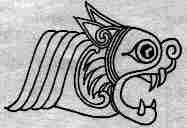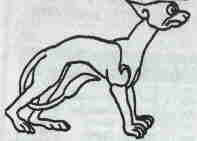
Kell-riffic!
Book of Kells has a long, rich history
Published 10/2/97
Located in the heart of Trinity College's 18th century library in Dublin, Ireland, lies a link to the past. After surviving over 1,000 years of war, theft and vandalism, the Book of Kells still has its pages turned on a regular basis by people ranging from students to priests.
Historians say the Book of Kells' origin can be either be traced to Kells, a city some 40 miles northwest of Dublin, or on the Island of Iona, located off the west coast of Scotland. Containing the four Gospels - Matthew, Mark, Luke and John - the Book of Kells is carefully crafted and illustrated. In fact, out of its 680 pages, only one page doesn't have an illustration in it.
The pages, which are made of calf skin, are written in a Latin text that bears the resemblance to Egyptian and Middle East writings. With a triangular form found at the top of the letters, however, people believe the text resembles that at Roman Hand more than anything else.
 Originally
created as a one-volume book, the Book of Kells was divided about
40 years ago into four volumes, one for each of the Gospels. Each
of the Gospels have their own identity. The symbol for St.
Matthew was a man, the symbol for St. Mark was a lion, the symbol
for St. Luke was a calf and the symbol for St. John was an eagle.
Many times these illustrations were used to help the reader
understand what was going on. For example, the world
"Nemo" ('No man'), which is used in the passage
"No man can serve two masters'", is formed of two men
tugging and fighting each other.
Originally
created as a one-volume book, the Book of Kells was divided about
40 years ago into four volumes, one for each of the Gospels. Each
of the Gospels have their own identity. The symbol for St.
Matthew was a man, the symbol for St. Mark was a lion, the symbol
for St. Luke was a calf and the symbol for St. John was an eagle.
Many times these illustrations were used to help the reader
understand what was going on. For example, the world
"Nemo" ('No man'), which is used in the passage
"No man can serve two masters'", is formed of two men
tugging and fighting each other.
Some of the illustrations were large enough to take up entire pages while others took up inches. Capital letters starting new paragraphs were commonly ornamented to help a reader find their place in the book since the Book of Kells was originally written in one volume.
Illustrations were used for other reasons as well. Sometimes a drawing would be used simply to fill up space at the end of a line of text, or if a monk forgot to put put in a word while transcribing a passage, they would insert the missing text at the bottom of the page next to a drawing of a guard dog to to inform the reader of the mistake.
 Originally
appearing at Kells in 804 A.D., the Book of Kells was delivered
by Irish monks fleeing from Viking Raiders. The book stayed there
until 200 years later during the time of the Norman Conquest when
it was stolen for its monetary value. Although semiprecious
stones, such as lapis lazoli, which is only found in the
foothills of the Himalayan Mountains, were used in the color of
the book, it was believed to have a gold-and-jewel encrusted case
that may have tempted thieves to steal the book. Proof of this
assertion is justified when, after it was stolen in 1007, the
Book of Kells' pages were found several weeks later buried in the
ground.
Originally
appearing at Kells in 804 A.D., the Book of Kells was delivered
by Irish monks fleeing from Viking Raiders. The book stayed there
until 200 years later during the time of the Norman Conquest when
it was stolen for its monetary value. Although semiprecious
stones, such as lapis lazoli, which is only found in the
foothills of the Himalayan Mountains, were used in the color of
the book, it was believed to have a gold-and-jewel encrusted case
that may have tempted thieves to steal the book. Proof of this
assertion is justified when, after it was stolen in 1007, the
Book of Kells' pages were found several weeks later buried in the
ground.
After being retrieved, the Book of Kells stayed in Kells until it was moved to Trinity College in the 1660s, and that's where it currently resides.
Trinity College Library is also home to another Irish Gospel book, the Book of Durrow, which was written around 675 A.D. The library pays for the preservation of the Book, of Kells, the Book of Durrow and its other 200,000 older books by receiving royalty payments from the full-color facsimile of the Book of Kells.
The above artwork can be found in the Book of Kells.
Click here to return to feature index.